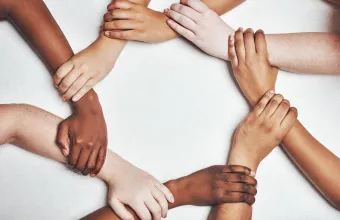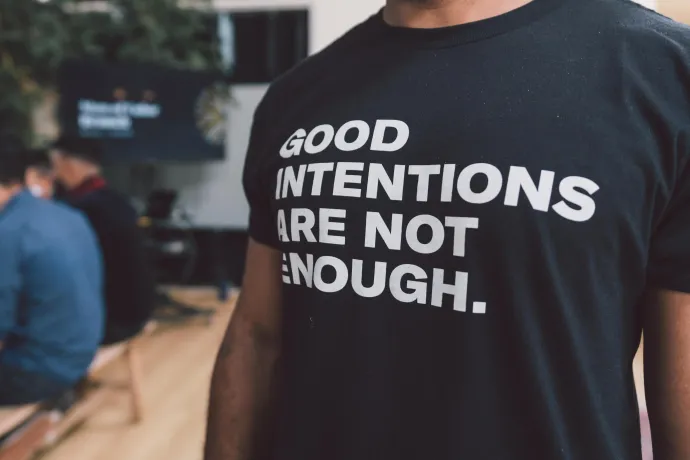Standing Out, Fitting In, and the Dilemma of Being the Only
Karen L. shares her story of being the only girl playing soccer on an all boys' soccer team, and how that experience of isolation fuels her to create a welcome workplace environment for new hires on her Symantec team.
Despite the often-repeated advice to just “be yourself,” I know from experience that it’s not always fun to be different. We humans are a tribal bunch, and being “the only” or “the first” anything can be a lonely and isolating experience, even for an adult. For a kid, it can be excruciating.
When I was growing up in southern Orange County, CA many eons ago, soccer was still widely unknown. The game that dominates the rest of the world was an enigma in The OC at that time – often confused with rugby, lacrosse, and even occasionally jai alai. Unless one’s parents hailed from other countries or were graduates of East Coast prep schools, the only kind of “football” kids talked about was the American kind.
I learned the rudiments of the game at age fourteen in the street in front of my older sister’s boyfriend’s house. He and his four brothers had recently arrived from Mexico, speaking very little English. The only bilingual activity available to me was kicking a soccer ball around with “the boys.”
I soon picked up the basics (along with some colorful Spanish slang, but that’s another story). The brand-new high school I attended was in the process of putting together its first boys’ soccer team, and the pickings at the first tryout were slim: a handful of exchange students from Latin America and Europe, some off-season cross-country runners, and me. And I was only there because my sister’s boyfriend made me.
Despite a lifelong history as a tomboy – leading a small gang of neighborhood boys in cap gun fights and skateboard stunt competitions – I had abruptly reached the age where being the only girl in a sea of masculinity was, well, mortifying. I ended up making the team (believe me, it wasn’t hard), and thanks to Title IX (which mandates that female athletes be allowed to compete with males if they don't have an equivalent offering), I became the first girl to play boys’ soccer in that part of Southern California.
Despite a lifelong history as a tomboy I had abruptly reached the age where being the only girl in a sea of masculinity was mortifying.
And compete I did. Because I was the only girl (both on my team and in the league), every time I took the field I felt I had to prove myself. Did I truly have the skills to earn my place on the team? Or was I some kind of novelty act, included only because the law demanded it? Each time we faced a new opponent, the players on the other team were initially thrilled that they were up against “the girl.” However, their elation turned to consternation the first time I beat them to the ball. And virtually every time that happened, my opponent was subjected to loud derision from the sidelines – mostly from his own teammates and supporters, even his coaches.
But then if my opponent doubled down and fought me more aggressively for control of the ball, he was also jeered – this time not for losing to a girl, but for being too rough with one. The poor guys literally couldn’t win; they got grief no matter what they did. And I felt both ashamed of my unfair advantage and guilty about being the cause of all their grief. Regardless of what I did, I stood out, when all I wanted was to fit in. My behavior didn’t matter – my mere presence changed the dynamic completely.
Regardless of what I did, I stood out, when all I wanted was to fit in. My behavior didn’t matter – my mere presence changed the dynamic completely.
Fast-forward to now. Like most Symantec employees, I’m still part of a team, although now that team develops content for email security products instead of kicking balls around. My Symantec team has dropped from five members to three in the past several months, and if all goes well, we’ll soon be looking to hire.
And here’s where my experience as “the first/the only” becomes relevant. I’ve never forgotten how hard it was to stand out – to feel I had to prove myself every day, to have my every act scrutinized, and to realize that my mere presence as “the only” was enough to change the tone of the group. As my team contemplates hiring a new member, we talk about trying to attract candidates who aren’t just like us – candidates who are diverse in terms of background, culture, age, and experience.
Fortunately, Symantec’s Diversity, Equity and Inclusion (DEI) team offers a variety of tools and approaches to help the company to work toward inclusion – including helping hiring managers and teams widen the candidate pool of people from underrepresented groups. Yvonne Thomson, VP of Culture at Symantec, spoke to my local San Francisco ERG chapter of SWAN (Symantec Women’s Action Network) earlier this year, and she described some initiatives currently underway that offer hope for real change.
I’ve never forgotten how hard it was to stand out – to feel I had to prove myself every day, to have my every act scrutinized, and to realize that my mere presence as “the only” was enough to change the tone of the group.
The People Analytics team now gathers extensive data on hiring and retention for employees who are not part of the standard “pale and male” tech workforce. Executives at the VP level and above are provided with customized dashboards that show exactly how their business units are doing when it comes to recruiting, hiring, and retaining women and people from other underrepresented groups. This will undoubtedly help push things along from the top.
Again, the DEI group comes to the rescue for teams who are looking to hire, offering a plethora of diverse recruiting channel resources, which provide us with easy access to female, Latinx, African American, Native American, military veteran, and LBGTQ candidates.
And to help these candidates feel more included during the hiring process, a pool of current employees from underrepresented backgrounds can devote 15% of their time to participate in interview panels across business units and locations. This initiative could help make potential hires feel more welcome, and more likely to believe that Symantec is a place for everyone, not just for those who look like those who are already here. That will be a winning combination.
We all know what it's like to be "the only" – whether you're the only girl playing soccer with the boys, the only person from your race, the only person with your religious views, the only woman in a sea of men. . . the list can go on. The question becomes, then: How do we create an inclusive environment where "the only" isn't so lonely?
Or better yet, where there are no longer any onlies left.








We encourage you to share your thoughts on your favorite social platform.